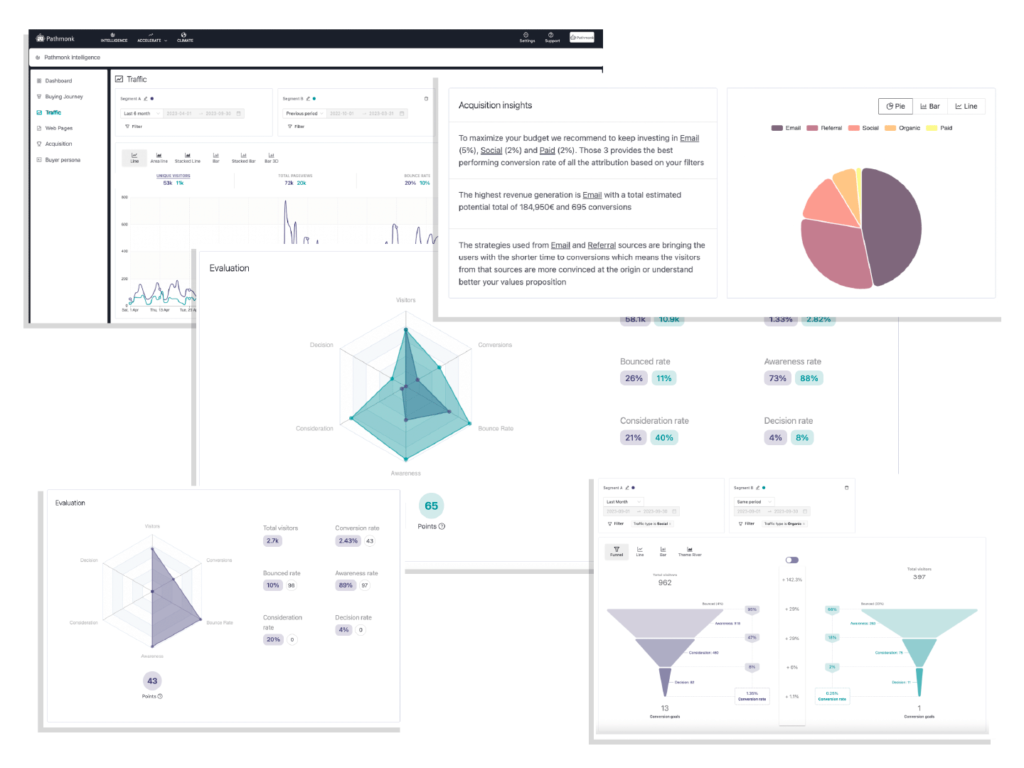How Can Email Marketing Fuel Your Overall Inbound Strategy?


Email marketing can play a crucial role in fueling your overall inbound marketing strategy by contributing to various aspects of the customer journey. This versatile tool, often overlooked in marketing strategies, not only connects businesses with their audience but also nurtures relationships, drives conversions, and enhances brand loyalty.
In this blog, we’re going to explore key ways in which email marketing can be strategically integrated into your inbound approach, amplifying its impact across the customer journey, and ultimately optimizing your conversion rate.
Table of Contents
Understanding the Essence of an Inbound Marketing Strategy
Inbound marketing embodies a transformative approach that prioritizes building genuine connections with your audience. At its core, this strategy revolves around the creation and dissemination of valuable content tailored to address the specific needs and interests of your target demographic. By cultivating an environment where potential customers actively seek out information, businesses can position themselves as industry authorities, fostering trust and loyalty.
The essence of an inbound marketing strategy lies in its customer-centricity. Instead of bombarding consumers with intrusive messages, it seeks to attract, engage, and delight them through meaningful interactions. This involves leveraging various channels such as SEO, social media, and email marketing to seamlessly guide prospects through the buyer’s journey. As organizations craft compelling content, optimize for search engines, and embrace personalized communication, they not only attract leads but also nurture relationships that extend beyond mere transactions.
Ultimately, the goal of inbound marketing is about creating a positive, value-driven experience that resonates with your audience, leading to sustainable growth and brand advocacy.
Email Marketing Across the Customer Journey: A Strategic Approach
Email marketing serves as a linchpin across the customer journey, weaving a strategic thread from the initial point of attraction to the ongoing delight of loyal customers. Let’s delve into the intricacies of how email marketing can be integrated into each stage of the customer journey:
Awareness Stage: Lead Generation and Opt-ins
In the attraction phase, email marketing becomes the catalyst for lead generation. By enticing potential customers with valuable lead magnets—such as exclusive content, webinars, or downloadable resources—businesses can build a curated list of opt-in subscribers who express genuine interest in their offerings.
For instance, a tech consulting firm like Gartner strategically leverages email marketing to initiate this process. Recognizing the importance of providing valuable insights to their target audience, Gartner offers a comprehensive industry report as a B2B lead magnet. This report, encompassing the latest trends, market analysis, and actionable strategies, serves as an enticing proposition for professionals seeking in-depth knowledge and forming a valuable list of subscribers eager for more insights.
Conversion Phase: Nurturing Leads with Drip Campaigns
Moving into the conversion phase, automated drip campaigns take center stage. These email sequences should deliver targeted content to nurture leads, guiding them through the decision-making process. From informative emails to compelling calls to action, this personalized approach maximizes the chances of turning prospects into customers.
A retail business such as Decathlon, renowned for its wide range of sporting goods, strategically employs drip campaigns to facilitate a seamless transition from interest to purchase. Recognizing that customers often embark on a journey of exploration before making a buying decision, Decathlon designs its drip campaigns to provide valuable information, build trust, and enhance the overall customer experience, nurturing the lead toward making a purchase.
Closing Phase: Segmentation for Precision Messaging
As prospects move closer to making a decision, email marketing shines in its ability to segment the audience. By understanding demographics, behavior, and preferences, businesses can send highly targeted messages. This precision ensures that potential customers receive tailored information, deals, and offers, boosting the effectiveness of closing strategies.
For example, the e-commerce company SheIn, specializing in fashion and trendy apparel, strategically harnesses the power of segmentation to enhance its closing phase. Recognizing that different segments of its audience have varying tastes, preferences, and shopping behaviors, SheIn tailors its email campaigns to address these nuances and provide a personalized and compelling shopping experience, maximizing the chances of a repeat purchase.
Delight Phase: Retention and Customer Satisfaction
Beyond the sale, email marketing continues to play a vital role in the delight phase. Loyalty programs, exclusive offers, and personalized communications foster a sense of appreciation among existing customers. Regular communication through email ensures that the brand remains top-of-mind, contributing to long-term customer satisfaction and loyalty.
For instance, the renowned coffee chain Starbucks excels in utilizing email marketing to enhance the delight phase of its customer journey. Recognizing the importance of nurturing ongoing relationships with its coffee enthusiasts, Starbucks implements a range of strategies to keep customers engaged and satisfied.
Email Marketing Inbound Strategies
A strategic deployment of email marketing across the customer journey transforms it from a mere communication tool into a dynamic force that propels prospects into loyal customers. Understanding and harnessing its capabilities at each stage ensures a comprehensive and personalized customer experience, ultimately driving business growth and success. These are the most successful email marketing strategies to boost your inbound marketing.
1. Content Distribution: Enhancing Engagement
Email serves as a steadfast channel for content distribution throughout the customer journey. Businesses leverage this medium to share diverse content, including blog updates, industry insights, and informative newsletters. This continual delivery of valuable content not only keeps the audience engaged but also actively contributes to brand positioning and authority within the industry.
2. Personalization Strategies: Deepening Connections
The prowess of email marketing lies in its ability to personalize messages based on user behavior, preferences, and demographics. This personalized approach creates a more profound and meaningful connection with recipients, fostering a sense of understanding. Throughout every phase of the customer journey, this tailored communication strengthens the brand-customer relationship.
3. Automated Workflows for Each Stage
Email automation allows you to set up workflows that trigger specific emails based on user actions. This can include welcome emails, follow-up messages, and abandoned cart reminders, ensuring timely and relevant communication with your audience that match their real-time intent.
4. Feedback and Improvement: Informed Decision-Making
Email marketing forms a valuable feedback loop through surveys and analytics. By diligently collecting data on metrics such as open rates, click-through rates, and customer responses, businesses gain valuable insights into audience preferences. This data-driven approach enables continuous improvement and optimization of email campaigns, ensuring relevance and effectiveness.
5. Multichannel Integration: Unified Brand Experience
For a seamless brand experience, email marketing seamlessly integrates with other inbound channels. This strategic alignment, whether with social media strategies or content marketing efforts, establishes consistent branding and messaging across various platforms throughout the customer journey.
Evaluating Email Marketing’s Impact on Your Buying Journey
Whether you’re aiming to boost awareness, guide consideration, or drive conversions, Pathmonk Intelligence simplifies the process. It’s the key to understanding the impact of your email marketing efforts, allowing you to make informed decisions and optimize your strategy for a more effective buying journey.
Pathmonk Intelligence analyzes every visitor’s journey on your website throughout the buying process. It observes how each channel contributes to the awareness, consideration, and conversion stages, providing a holistic view of your marketing efforts.
Intuitive Cookieless Analytics for Your Web
Understand your customer journey, find drop-offs, and receive actionable insights with AI.

1. Comprehensive Traffic Analysis
Imagine having a trusted ally that tracks every step of your audience’s interaction with your website. Pathmonk Intelligence precisely monitors the traffic generated by your email campaigns, shedding light on how users move from being aware of your brand to considering your offerings and, finally, making a purchase decision.
2. Channel Performance Breakdown
Not all channels perform equally across the buying journey. With Pathmonk Intelligence, you can easily discern how your email marketing compares to other channels in terms of creating awareness, nurturing consideration, and driving conversions. This breakdown empowers you to allocate resources more efficiently based on actual performance.
3. Understanding Email Marketing Influence
Pathmonk Intelligence unveils the specific impact of your email marketing efforts. By assessing the journey of users who engaged with your emails, you gain valuable insights into how effective your email campaigns are at each stage of the buying process and how many of them have resulted in conversions.
4. And It’s 100% Cookieless
Unlike traditional analytics tools, Pathmonk Intelligence operates without relying on cookies. This cookieless approach ensures compliance with privacy regulations while still delivering robust insights. Marketers can confidently analyze customer journeys, knowing they’re respecting privacy and receiving accurate data for informed decision-making.
Conclusion: Unleashing the Power of Email Marketing in Inbound Strategy
Email’s prowess in lead generation, personalized engagement, segmentation precision, and ongoing customer satisfaction positions it as a key element in a comprehensive inbound strategy. Leveraging analytics tools, such as Pathmonk Intelligence, further refines this influence, offering marketers a granular understanding of email campaigns’ efficacy.
As we navigate the evolving landscape of inbound marketing, let’s embrace the data-driven, customer-centric nature of email marketing. Its adaptability, coupled with strategic insights from analytics tools and the transformative potential of artificial intelligence, positions email as a foundational element in a robust and effective inbound strategy.





